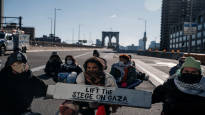New York, London and other parts of the world have seen large demonstrations on behalf of the Palestinians throughout the Gaza war.
The war began last October after Hamas terrorists attacked Israel from the Gaza Strip, killing 1,200 and taking about 240 hostages. After that, the Israeli army made a counterattack on Gaza, which is still going on.
Last week in New York, protesters briefly stopped traffic on several roads leading to Manhattan. In London, protesters laid down in the middle of a bridge near the Houses of Parliament.
Protesters in different countries are united by similar slogans. Cease fire now! From river to sea, Palestine will be free!
Age also connects. Based on the news photos, most of the protesters are young.
But wait a minute. Shouldn’t today’s youth just talk and chat with their cell phones? Aren’t physically demanding marches and other street protests yesterday’s thing?
– Not at all, it’s actually quite the opposite, says the professor of sociology Eeva Luhtakallio from the University of Helsinki.
– Social media has multiplied the visibility of protests and it has become an effective tool for organizing protests, Luhtakallio continues.
According to Luhtakallio, who has studied citizen activism, contrasting street and online protest is artificial. Both are influencing, and a showy protest is often good social media content that is interesting to the public.
A lot of pictures and videos of the protests in New York and London have been shared on social media.
– A performance made on the street gets a new life online. It can be commented on and new meanings can be attached to it, the professor thinks.
The wrong is interesting
The history of demonstrations begins with bread riots. For centuries, people took to the streets mostly when they were sure to die of starvation.
Today, people are not driven to protest by an empty stomach – but by emotions.
– Dismay, the experience of something clearly wrong, has traditionally been the reason that brings people to the streets in prosperous Western countries, describes Professor Luhtakallio.
The casualties of the Gaza war have caused consternation. According to the Hamas-led Palestinian Authority, more than 24,000 people have died in the Gaza Strip, of which more than 10,000 are children. The Israeli army says having killed or captured 9,000 Hamas fighters.
– If there’s one reason for the protests, it’s the scale. These are really large numbers of victims and they raise concerns about the catastrophic situation of Gaza’s civilians, says a researcher specializing in the Middle East and Palestine Mikko Joronen from the University of Tampere.
– When these figures are combined with the rather weak positions of the leaders of Western countries and the continuation of support for Israel, it creates anger, Joronen continues.
According to the researcher, people’s reactions are also a result of the change in the media environment.
At the same time that the media committed to journalistic principles seem to be narrowly publishing content from conflict areas, social media channels are pouring out dramatic material from the ground in Gaza. Journalists from foreign media have not been allowed to work freely in the Gaza Strip.
According to Jorone, the paucity of material produced in Gaza in the Western media can make one wonder to what extent the traditional media’s image of the conflict can be trusted.
Slow processes go unnoticed
There are enough worries in the world, but people are not marching in the streets to oppose the automation of working life or, say, the rise of an authoritarian China.
– Slow-developing processes rarely arouse great emotions in people, says Professor Luhtakallio.
Dissatisfaction that manifests itself in street protests is usually a feeling that has been pent up over a long period of time, which then erupts due to a suitable event.
– The conflict between Palestine and Israel involves emotions that have been raging for decades. Now the war in Gaza is the single event that brings them to the surface, says Luhtakallio.
The easiest thing to protest is one’s own country
In the 1980s, Western Europe marched against America’s nuclear weapons. The following decade saw opposition to the liberalization of world trade and later to the US invasion of Iraq.
In Western countries, it is typical for protests that they oppose the government of their own country or the world order led by the United States.
When Russia invaded Ukraine, few in the West took to the streets to march.
According to the researchers, this is understandable for two reasons. First, Western leaders clearly condemned the Russian attack.
Because of this, the protests did not have the same social order as in the context of the Gaza conflict. The matter can also be approached practically.
– It is unlikely that Russia would have been interested in, for example, what is being protested in Finland. In democracies, of course, things are different, summarizes Professor Luhtakallio.
However, it is difficult to assess the impact of demonstrations in support of the Palestinians on the politics of Western countries.
For now, US support for Israel’s war effort continues and civilian casualties in Gaza continue to rise.
– Significant expressions of opinion are important, but their impact is more difficult to define. Of course, the fact that things are talked about always has some meaning, says researcher Mikko Joronen from the University of Tampere.
